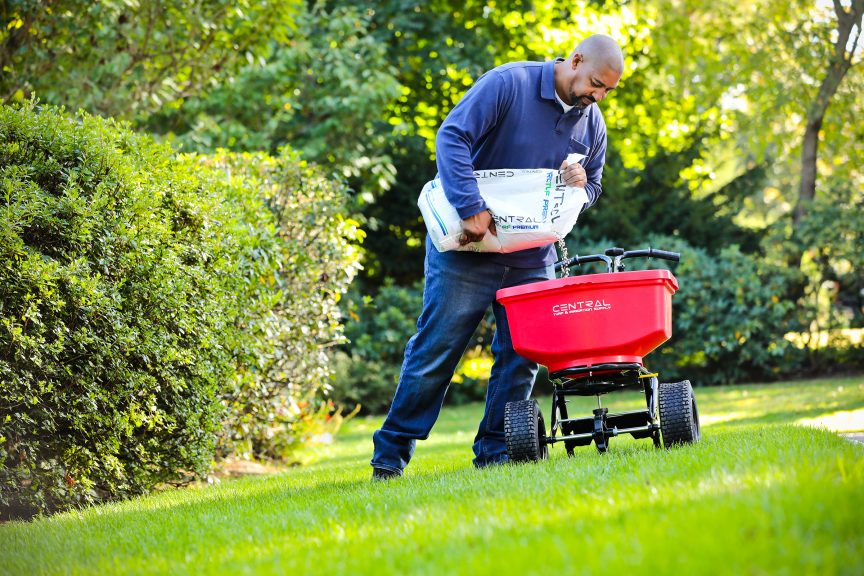Now that spring in here and the temperatures are warming up, its time to get a jump on crabgrass breakthrough. Preventative care is your best chance at slowing and stopping crabgrass this a season.
We’ve connected with Bob Hartman, our Director of Turf, to learn a little more about two popular and effective crabgrass control products, Prodiamine and Dithiopyr.
From Bob Hartman:
I often get asked, “What is the difference between Prodiamine and Dithiopyr? Both of these products have excellent crabgrass pre-emergence properties. Usually it boils down to the part of the country you are in, the type of grass you are applying it on, the amount of crabgrass pressure you have as well as the amount of precipitation we get.
What are the Main Differences between Prodiamine and Dithiopyr?
- Prodiamine is preemergent only while Dithiopyr is both a pre-emergent and post emergent (for crabgrass only). Both Prodiamine and Dithiopyr are safe on most warm- and cool-season grasses. These are the generic names but there is chemistry out there with their own brand names but I will stick to the generic name for this article.
- Pre-emergent products don’t actually stop the seed from germinating as one would expect. As the seed germinates, the tiny seedling comes in contact with the pre-emergent chemical layer in the soil and absorbs it. The chemical reaction between the active ingredient and the plant causes it to die. Hence why we call them pre-emergents. They kill the seedling prior to emerging from the soil, but they don’t kill the seed. Over time, pre-emergents are broken down by a myriad of factors like rainfall, irrigation, microbes as well as disturbing the top layer of soil where the AI resides. When that barrier is broken, crabgrass seedlings are no longer affected by the AI on the ground and can begin sprout.
- Prodiamine is yellow in color and does come with an odor. Typically, the Prodiamine is put down as a first application for crabgrass prevention. It works well and can come in a few different AI loads depending on your area of the country, timing, and crabgrass pressure. Prodiamine performs much better in the transition zone and in the south than does Dithiopyr. Prodiamine does not leach into the ground with heavy rainfall the way Dithiopyr can. So, if they are predicting a heavy spring rainfall this year in your area, Prodiamine may be the better choice. Prodiamine is also cheaper than Dithiopyr.
- Dithiopyr is clear in color and has virtually no odor. Applicators like the fact that they are personally not stained yellow and the spreader does not have as much build up on it. It also has a wider window for application. The Dithiopyr however, has both pre- and post-emergent capabilities. As long as the crabgrass plant has not grown out beyond 5 tillers, Dithiopyr should kill the crabgrass. Depending on the desired grass height and area of the country, the amount of AI per acre will vary. The more AI that goes down, the longer the effectiveness on the control you will have. Always check the label for your grass type and area of the country. Dithiopyr is almost always more expensive than Prodiamine.
Doubling Down: Often times it is best to run split applications of pre-emergents in the spring. It is best to start with Prodiamine and then follow that treatment up with a Dithiopyr treatment. There are Split applications of a pre-emergent are almost always your best bet. There are a few good reasons to do this in the spring; but the most important is not only the post emergence control you get with Dithiopyr, but also the fact that you are extending your window of crabgrass control. Another reason is it is always good to change up your chemistry every so often because weeds can build up a tolerance to certain active ingredients over time.
Below are 5 tips to remember when applying your pre-emergent fertilizer:
- Calibrate! Calibrate! Calibrate!Always make sure your spreaders are calibrated per the manufacturer’s instructions. Otherwise you could under or over apply which can cost extra money in the long run (either extra materials costs or man hours).
- Always follow the label for proper application rates and timing
- Always wear safety equipmentand personal protection equipment when dealing with these various chemistries.
- Always follow local, state and federal lawwhen applying fertilizers and chemicals.
- Always waterin as soon as possible.
About Bob Hartman
Bob Hartman is an industry veteran with more than 15 years of experience in the green industry; specifically, turf. Bob brings a solid background in both the organic and synthetic methods of feeding turf and plants. His diverse background and experience on the manufacturing makes him an excellent resource to help you grow your business.
Finally, rely on Central to help, whether it’s questions about the newest innovations in agronomics, organic & low-impact programs, or finding the right solutions for a problem area. We stay at the leading edge of the industry and we’re ready to help you grow!

